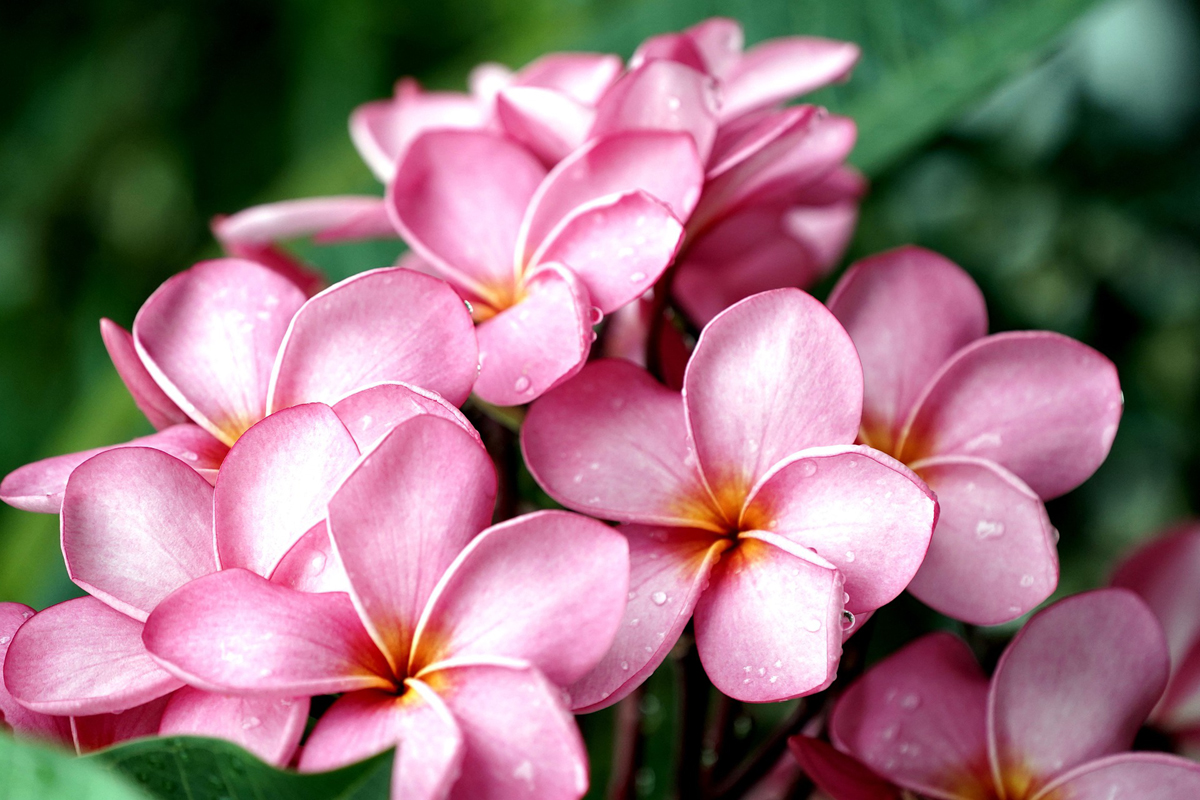Tropical Plants and Plumeria Care in Temperate Climates

When it comes to growing tropical plants, including plumerias, some gardeners will tell you that these plants cannot be grown in temperate climates. Recently, I have been asked how tropical plants and plumerias can be grown in less than ideal conditions meaning outside their native subtropical and tropical climates.
Tropical plant lovers can let their imagination run wild in creating tropical gardens of their own with all the new plants and information that is available to them these days. No longer do they have to listen to all the naysayers telling them it can’t be done. Gardeners can create a tropical garden with banana plants, heliconias, plumerias, and other beautiful exotic tropical plants. Many of these tropical plants have been developed and hybridized for this very reason.
In temperate climates gardeners have to grow their tropical plants in pots, and supplement what is needed to re-create their native conditions. The tropical plant gardener in temperate climate zones has to adjust the plants and growing conditions to fit his or her local garden parameters.
For example, if a gardener wants to include banana plants in the garden design, instead of growing banana plants that grow twelve feet or more, like Musa ‘Ice Cream’ and Musa ‘Monthan’, growing dwarf fruiting banana plants is the available and correct choice.
Excellent dwarf fruiting banana plants include Musa acuminata ‘Dwarf Cavendish’, Musa acuminata ‘Dwarf Lady Finger’, and Musa acuminata ‘Super Dwarf Cavendish’. These dwarf banana plants don’t take up much space and can produce fruits when provided with the correct growing conditions.
Another excellent alternate choice to grow in temperate climates are ornamental banana plants, called Musa ornata. They produce colorful inflorescence flower stalks, which carry inedible banana fruits. Colors of the inflorescences include red, white, purple and pink. An excellent edible choice is Musa velutina, also called pink flowering banana. The fruit is actually edible if one doesn’t mind the seeds. The bananas actually peel themselves back when ripe. Musa velutina starts flowering and fruiting once it reaches three feet in height.
When traveling to tropical destinations vacationers encounter heliconias growing in the wild. Many heliconias grow so tall that they would not be considered suitable for container growing.
But there are also many smaller heliconias available that can be grown successfully in pots outside during the summer months and inside during the colder months of the year. One group is Heliconia psittacorum which grows happily in a pot. Cultivars include Heliconia psittacorum ‘Lady Di’, Heliconia psittacorum ‘Strawberries and Cream’, and Heliconia psittacorum ‘Andromeda’. Several plants of Heliconia stricta can also be successfully grown in containers, including Heliconia stricta ‘Firebird’, Heliconia stricta ‘Sharonii’, and Heliconia stricta ‘Bucky’.
If one’s growing space is restricted or limited in size, Heliconia stricta ‘Dwarf Jamaican’ is an excellent choice. This is a true dwarf heliconia not growing more than two to three feet high. It is a bushy plant with heavily pleated leaves which have a thin red stripe down the center. The bracts look like miniature lobster claws and are comparatively large in contrast to the size of the plant. These bracts last a long time.
Plumeria plants are another group of tropical plants thought to be impossible to grow in temperate climates. By providing the correct plumeria care these plants can be grown as far north as Alaska. Plumeria care involves choosing the correct potting mix, soil additives, fertilizers, and more. This is true for all tropical plants.
There is a feeling of serenity when one watches the flowers of plumeria plants which come not only in many different colors such as white, red, yellow, pink and rainbow, but also have unforgettable fragrances which include citrus, coconut, gardenia, jasmine, peaches, roses and many more.
Plumeria plants can grow quite tall, but can be maintained at the desired height with the correct pruning techniques. In recent years several dwarf varieties have been introduced, including Plumeria obtusa ‘Dwarf Singapore Pink’, Plumeria rubra ‘Divine’, and Plumeria rubra ‘Mini-White’. Divine and Mini-White are considered true miniatures.
Another dwarf hybrid is Plumeria obtusa ‘Dwarf Deciduous’ which produces large white flowers with a strong citrus fragrance.
Plumerias over the last fifteen to twenty years have gained more and more gardeners’ attention worldwide. More and more international gardeners who have experienced plumerias first hand through their travels, or have discovered them on the internet are including them in their tropical garden designs. Plumerias are also known and called ‘Frangipani’ which is their recognizable name around the world.
These are just a few examples of tropical plants which can be grown successfully with proper care in temperate climates. Other plants that the tropical gardeners can include in their newly designed gardens are gingers, calatheas, proteas, and tropical rhododendrons.
If you have fallen in love with tropical plants and want to create your exotic tropical garden oasis in the temperate zone where you reside, go ahead and give it a go. New discoveries and gardening methods have opened the door for new possibilities to grow the garden closest to your heart’s desire, even if the local trusted gardeners haven’t kept up with all these new gardening developments.
Especially, if tropical plants are at the center of your gardening dreams, find a good current tropical plant care guide and read up on the newest methods that are out there and available.
The Author:
howtogrowplumeriafrangipani








